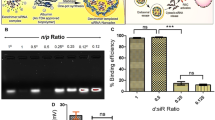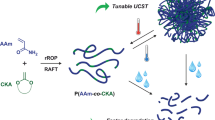Abstract
We have synthesized a polymeric drug carrier, polyvinylpyrrolidone-co-dimethyl maleic anhydride [poly(VP-co-DMMAn)], for use in renal drug delivery. About 80% of the 10-kDa poly(VP-co-DMMAn) selectively accumulated in the kidneys 24 h after intravenous administration to mice. Although this accumulated poly(VP-co-DMMAn) was gradually excreted in the urine, about 40% remained in the kidneys 96 h after treatment. Poly(VP-co-DMMAn) was taken up by the renal proximal tubular epithelial cells and no cytotoxicity was noted. Higher doses did not produce toxicity in the kidneys or other tissues. In contrast, polyvinylpyrrolidone of the same molecular weight did not show any tissue-specific distribution. Poly(VP-co-DMMAn)-modified superoxide dismutase accumulated in the kidneys after intravenous administration and accelerated recovery from acute renal failure in a mouse model. In contrast, polyvinylpyrrolidone-modified superoxide dismutase and native superoxide dismutase were not as effective. Thus, poly(VP-co-DMMAn) is a useful candidate as a targeting carrier for renal drug delivery systems.
This is a preview of subscription content, access via your institution
Access options
Subscribe to this journal
Receive 12 print issues and online access
$209.00 per year
only $17.42 per issue
Buy this article
- Purchase on Springer Link
- Instant access to full article PDF
Prices may be subject to local taxes which are calculated during checkout






Similar content being viewed by others
References
Jones, C.A. et al. Serum creatinine levels in the US population: Third National Health and Nutrition Examination Survey. Am. J. Kidney Dis. 32, 992–999 (1998).
Progress and Priorities: Renal disease research plan. Report of the strategic planning conferences, Renal research properties- sponsored by National Institute of Diabetes and Digestive and Kidney Disease, Council of American Kidney Societies, (December 5–6, 1998 & February 4–5, 1999). (http://www.niddk.nih.gov/federal/planning.htm#g)
Elfarra, A.A., Duescher, R.J., Hwang, I.Y., Sicuri, A.R. & Nelson, J.A. Targeting 6-thioguanine to the kidney with S-(guanin-6-yl)-L-cysteine. J. Pharmacol. Exp. Ther. 274, 1298–1304 (1995).
Haverdings, R.F. et al. Potentials and limitations of the low-molecular-weight protein lysozyme as a carrier for renal drug targeting. Ren. Fail. 23, 397–409 (2001).
Schechter, B., Arnon, R., Colas, C., Burakova, T. & Wilchek, M. Renal accumulation of streptavidin: Potential use for targeted therapy to the kidney. Kidney Int. 47, 1327–1335 (1995).
Inoue, M., Ebashi, I., Watanabe, N. & Morino, Y. Synthesis of a superoxide dismutase derivative that circulates bound to albumin and accumulates in tissues whose pH is decreased. Biochemistry 28, 6619–6624 (1989).
Rypacek, F., Drobnik, J., Chmelar, V. & Kalal, J. The renal excretion and retention of macromolecules: The chemical structure effect. Pflugers Arch. 392, 211–217 (1982).
Miyaji, T., Hu, X. & Star, R.A. α-Melanocyte-simulating hormone and interleukin-10 do not protect the kidney against mercuric chloride-induced injury. Am. J. Physiol. Renal Physiol. 282, F795–801 (2002).
Ghielli, M. et al. Antibodies to both ICAM-1 and LFA-1 do not protect the kidney against toxic (HgCl2) injury. Kidney Int. 58, 1121–1134 (2000).
Nishikawa, M. et al. Synthesis and pharmacokinetics of a new liver-specific carrier, glycosylated carboxymethyl-dextran, and its application to drug targeting. Pharm. Res. 10, 1253–1261 (1993).
Simionescu, N. Cellular aspects of transcapillary exchange. Physiol. Rev. 63, 1536–1579 (1983).
Chang, R.L., Deen, W.M., Robertson, C.R. & Brenner, B.M. Permselectivity of the glomerular capillary wall: III. Restricted transport of polyanions. Kidney Int. 8, 212–218 (1975).
Moestrup, S.K. et al. Megalin-mediated endocytosis of transcobalamin-vitamin-B12 complexes suggests a role of the receptor in vitamin-B12 homeostasis. Proc. Natl. Acad. Sci. USA 93, 8612–8617 (1996).
Sweet, D.H., Wolff, N.A. & Pritchard, J.B. Expression cloning and characterization of ROAT1. The basolateral organic anion transporter in rat kidney. J. Biol. Chem. 272, 30088–30095 (1997).
Hosoyamada, M., Sekine, T., Kanai, Y. & Endou, H. Molecular cloning and functional expression of a multispecific organic anion transporter from human kidney. Am. J. Physiol. 276, F122–128 (1999).
Nakajima, N. et al. Developmental changes in multispecific organic anion transporter 1 expression in the rat kidney. Kidney Int. 57, 1608–1616 (2000).
de la Escalera, S. & Palacian, E. Dimethylmaleic anhydride, a specific reagent for protein amino groups. Biochem. Cell Biol. 67, 63–66 (1989).
Nieto, M.A. & Palacian, E. Effects of temperature and pH on the regeneration of the amino groups of ovalbumin after modification with citraconic and dimethylmaleic anhydrides. Biochim. Biophys. Acta 749, 204–210 (1983).
Kaneda, Y. et al. Antitumor activity of tumor necrosis factor alpha conjugated with divinyl ether and maleic anhydride copolymer on solid tumors in mice. Cancer Res. 58, 290–295 (1998).
Kamada, H. et al. Molecular design of conjugated tumor necrosis factor-alpha: synthesis and characteristics of polyvinyl pyrrolidone modified tumor necrosis factor-alpha. Biochem. Biophys. Res. Commun. 257, 448–453 (1999).
Tsunoda, S. et al. Selective enhancement of thrombopoietic activity of PEGylated interleukin 6 by a simple procedure using a reversible amino-protective reagent. Br. J. Haematol. 112, 181–188 (2001).
Tsutsumi, Y. et al. PEGylation of interleukin-6 effectively increases its thrombopoietic potency. Thromb. Haemost. 77, 168–173 (1997).
Mu, Y. et al. Bioconjugation of laminin-related peptide YIGSR with polyvinyl pyrrolidone increases its antimetastatic effect due to a longer plasma half-life. Biochem. Biophys. Res. Commun. 264, 763–767 (1999).
Kamada, H. et al. Antitumor activity of tumor necrosis factor-α conjugated with polyvinylpyrrolidone on solid tumors in mice. Cancer Res. 60, 6416–6420 (2000).
Tsunoda, S. et al. Molecular design of polyvinylpyrrolidone-conjugated interleukin-6 for enhancement of in vivo thrombopoietic activity in mice. J. Control. Release. 68, 335–341 (2000).
Tsutsumi, Y. et al. Site-specific chemical modification with polyethylene glycol of recombinant immunotoxin anti-Tac(Fv)-PE38 (LMB-2) improves antitumor activity and reduces animal toxicity and immunogenicity. Proc. Natl. Acad. Sci. USA 97, 8548–8553 (2000).
Tsutsumi, Y. et al. Molecular design of hybrid tumour necrosis factor α with polyethylene glycol increases its anti-tumour potency. Br. J. Cancer 71, 963–968 (1995).
Corvo, M.L., Martins, M.V., Francisco, A.P., Moraris, J.G. & Cruz, E.M. Liposomal formulations of Cu,Zn-superoxide dismutase: physico-chemical characterization and activity assessment in an inflammation model. J. Control. Release 43, 1–8 (1997).
Veronese, F.M., Caliceti, P., Schiavon, O. & Sergi, M. Polyethylene glycol-superoxide dismutase, a conjugate in search of exploitation. Adv. Drug. Deliv. Rev. 54, 587–606 (2002).
Acknowledgements
We thank Ira Pastan for advice, discussion, and assistance. This study was supported in part by a Grant-in-Aid for Scientific Research (13672385) from the Ministry of Education, Science and Culture of Japan, and in part by Health Sciences Research Grants for Research on Health Sciences focusing on Drug Innovation from the Japan Health Sciences Foundation (KH63124).
Author information
Authors and Affiliations
Corresponding author
Ethics declarations
Competing interests
The authors declare no competing financial interests.
Rights and permissions
About this article
Cite this article
Kamada, H., Tsutsumi, Y., Sato-Kamada, K. et al. Synthesis of a poly(vinylpyrrolidone-co -dimethyl maleic anhydride) co-polymer and its application for renal drug targeting. Nat Biotechnol 21, 399–404 (2003). https://doi.org/10.1038/nbt798
Received:
Accepted:
Published:
Issue Date:
DOI: https://doi.org/10.1038/nbt798
This article is cited by
-
Effective Nephroprotection Against Acute Kidney Injury with a Star-Shaped Polyglutamate-Curcuminoid Conjugate
Scientific Reports (2020)
-
Long term safety of targeted internalization of cell penetrating peptide crotamine into renal proximal tubular epithelial cells in vivo
Scientific Reports (2019)
-
Transport and interactions of nanoparticles in the kidneys
Nature Reviews Materials (2018)
-
Cellular senescence in the aging and diseased kidney
Journal of Cell Communication and Signaling (2018)
-
Cellular senescence in renal ageing and disease
Nature Reviews Nephrology (2017)



